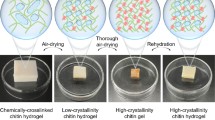Abstract
The goal of this study was to characterise the surface properties of completely degradable composite, polylactic acid and calcium phosphate glass, scaffolds. The composite scaffolds are made by solvent casting or phase-separation, using chloroform and dioxane as a solvent respectively. The surface properties were measured on composite films which were made using the same procedure as for the three-dimensional (3D) scaffolds without the pore-creating step. The surface morphology, roughness, wettability and protein adsorption capacity of the films was measured before and after sterilisation with ethylene oxide. The results reveal the influence of solvent type, glass weight content and sterilisation on the wettability, surface energy and protein adsorption capacity of the materials. The addition of glass particles increase the hydrophylicity, roughness and protein adsorption capacity of the surface. This effect, however, depends on the extent of the coating of the glass particles by the polymer film, which is much higher for dioxane films than for chloroform films. This information can be used to interpret and understand the biological behaviour of the 3D scaffolds made of this composite materials.
Similar content being viewed by others
References
D. W. HUTMACHER, Biomaterials 21 (2000) 2529.
L. C. LU and A. G. MIKOS, Mrs Bulletin 21 (1996) 28.
A. F. VON RECUM et al., in “Handbook of biomaterials evaluation. Scientific, Techincal and Clinical Testing of Implant Materials” (2005).
E. A. VOGLER, Advances in Colloid and Interface Science 74 (1998) 69.
M. NAVARRO et al., “Development of a biodegradable composite scaffold for bone tissue engineering: Physico-chemical”, (topographical, mechanical, degradation and biological properties, 2006)
M. NAVARRO et al., J. Am. Cera. Soc. 86 (2003) 1345.
B. D. RATNER, in “Biomaterials Science” (Elsevier Academic Press, 2004) 40.
LAM C.N. et al., in “Handbook of applied surface and colloid chemistry” (John Wiley and sons, Ltd., 2001) 251.
K. J. STOUT and L. BLUNT, in “Surface Topography” (Penton Press).
W. P. DONG et al., Wear 159 (1992) 161.
K. J. STOUT and L. BLUNT!, Surface and Coatings Technology 71 (1995) 69.
M. LUCK et al., J. Control Release 55 (1998) 107.
K. S. JEE et al., Biomacromolecules. 5 (2004) 1877.
F. RUPP et al., Biomaterials 25 (2004) 1429.
K. ANSELME, ibid. 21 (2000) 667.
P. Q. YING et al., Colloids and Surfaces B-Biointerfaces 32 (2003) 1.
C. D. MCFARLAND et al., J. Biomed. Mater. Res. 49 (2000) 200.
L. PONSONNET et al., Materials Science & Engineering C-Biomimetic and Supramolecular Systems 23 (2003) 551.
C. D. MCFARLAND et al., J. Biomed. Mater. Res. 44 (1999) 1.
J. W. LEE et al., Biomaterials 25 (2004) 1901.
J. W. LEE et al., J. Biomed. Mater. Res. 41 (1998) 422.
R. F. LENZA et al., J. Biomed. Mater. Res. 67A (2003) 121.
Author information
Authors and Affiliations
Corresponding author
Rights and permissions
About this article
Cite this article
Charles-Harris, M., Navarro, M., Engel, E. et al. Surface characterization of completely degradable composite scaffolds. J Mater Sci: Mater Med 16, 1125–1130 (2005). https://doi.org/10.1007/s10856-005-4717-4
Received:
Accepted:
Issue Date:
DOI: https://doi.org/10.1007/s10856-005-4717-4




